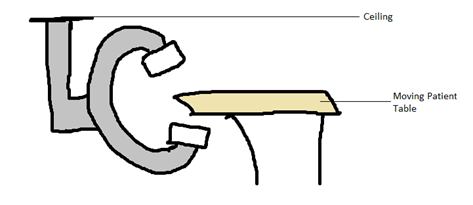This set of Clinical Science Multiple Choice Questions & Answers (MCQs) focuses on “Fluoroscopy”.
1. Fluoroscopy cannot be done without a dye.
a) True
b) False
View Answer
Explanation: Fluoroscopy is a process that depends upon the radioactivity of the dye to show the image. When the dye is injected or ingested, it emits radioactive waves which are captured/recorded using devices. Thus, for fluoroscopy, dye is a necessity.
2. Drinking radioactive Barium solution helps look at the _________
a) Respiratory Tract
b) Gastrointestinal Tract
c) Neural Tract
d) Thorax
View Answer
Explanation: When we swallow something, it always goes to the Gastrointestinal Tract. Radioactive barium in trace amounts is swallowed and the projected X-Ray beams photograph/record/project the whole process. The GI tract lights up and the examiner can see inside the track.
3. Which another method can be used to look in the compete for GI tract?
a) Endoscopy
b) Capsule Endoscopy
c) Colonoscopy
d) Laryngoscopy
View Answer
Explanation: Capsule Endoscopy can help look into the whole of the GI tract. The capsule has a miniature camera. The capsule is swallowed and as it moves down the track, it images the track. The images are either transmitted or stored and later recovered.
4. The following machine, along with fluoroscopy process is also used for minimal invasive surgery. Which machine is it?

a) X-Ray and fluoroscopy machine
b) CT scanner
c) C – Arm
d) MRI
View Answer
Explanation: C – Arm is used for diagnosis and minimally invasive procedures. The two plates at the end of the two arms have receiving and transmitting ends for X – Rays. The C – Arm can also rotate and move at various degrees thus providing access and visuals from many directions and angles.
5. Which of the following agents should not be used as an agent for fluoroscopy?
a) Silver
b) Bismuth
c) Thoria
d) Tungsten
View Answer
Explanation: Thoria stands for thorium dioxide. It was found to cause liver cancer so the use of thoria as an agent for fluoroscopy was discontinued. All the other three materials are still used for fluoroscopy but the dyes most preferred are made from iodine.
6. Fluoroscopy is an assistive process for __________
i. Discography ii. Podiatric Surgery iii. Orthopedic Surgery iv. Peripherally Inserted Central Catheter v. Percutaneous Diagnostic Interventions in Cardiology vi. Urology
a) i, ii, iv
b) i, iii, v
c) ii, iv, vi
d) i, ii, iii, iv, v, vi
View Answer
Explanation: All of the above mentioned processes require some sort of placement. Often some of these surgeries are minimally invasive so to visualize what is going inside the body, fluoroscopic dyes are used to keep monitoring them. Sometimes, after a surgery, to ensure that the wound is healing well or that the placements are in proper places, fluoroscopy can be used.
7. If a PET scan is being used to detect tumors, an important constituent of the injected radioligand will be _____
a) glucose
b) lipids
c) keratin
d) riboflavin
View Answer
Explanation: For any growing or recovering part of the body, the most important content is carbohydrate which is provided by glucose. Thus, to test for a suspected malignant tumour, a glucose based radioligand is used. This radioligand is absorbed by a tumour and it collects and becomes part of the normal functioning of the body. The more the collection of the radioligand at one place, greater is the size or the activity of a tumour.
8. Bone Scintigraphy done with the help of Tc-99m with methylene diphosphonate (MDP) is an example of ________
a) PET
b) SPECT
c) CT
d) MRI
View Answer
Explanation: SPECT uses Tc – 99m in its dyes. Bone Scintigraphy is a process in which the dye is injected and the bones are imaged. It can help look for cancer, inflammation, fractures etc. Since it can image with respect to time, it can also help plot out the metabolism of the bone.
Sanfoundry Global Education & Learning Series – Clinical Science.
To practice all areas of Clinical Science, here is complete set of 1000+ Multiple Choice Questions and Answers.
If you find a mistake in question / option / answer, kindly take a screenshot and email to [email protected]
- Check Clinical Science Books
- Apply for Biotechnology Internship
- Check Biotechnology Books
- Practice Biotechnology MCQs
